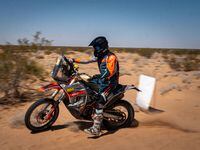Anyone who's ever ridden with an "untrained" passenger knows that their weaving and bobbing on the back of your bike isn't just annoying—it can be dangerous. That's because the 100- to 200-pound hunk o' burning love you've got riding pillion is what engineers call a "live load"—mass that can move about at random, upsetting the balance of your bike while trying to peer around you or, worse, naively leaning outward during a turn. It doesn't help that the load is up high and way at the back—exactly the opposite of the coveted "mass centralization" that bike builders have been so zealously pursuing for years.
Car drivers aren’t subject to these challenges for three reasons: (1) The passenger’s mass is essentially in the center of the vehicle; (2) belted in place and with a door beside them, passengers can’t weave around much; and (3) in a 4,500-pound car, a 150-pound passenger only adds 3 percent to the total weight, whereas on a 450-pound bike, that same passenger is 30 percent additional weight. This means that when moving from a car to a bike, the same passenger becomes the equivalent of the tail wagging the dog. And the larger the tail, the more it wags the dog.
Here are four strategies for keeping ride night with your sweetie right side up.
1) How to hold on. Passengers should find a way to hold on securely, without limiting the rider's ability to control the bike. Whether that's grasping the rider's waist or grab bars or simply using the backrest, do it consistently.
2) Lean on me. Riding nice and close helps centralize rider and passenger mass. The goal is to ride as one, with the passenger neither frantically clinging nor lazily slouching on the rear seat. Ride like the BFFs you are.
3) Follow my lead. Nobody ever won Dancing with the Stars out of sync with their partner. Instruct your passenger to mimic your moves on the bike in real time. Encourage them to "read the road" ahead.
4) Don't do nothin' sudden. As the "ship's captain," the rider should make nice, smooth control inputs and alert your passenger to upcoming maneuvers with a brief word, a nod of the head, or a nudge of the arm or leg.











/cloudfront-us-east-1.images.arcpublishing.com/octane/MPHXIIV54NAU5L6E4SYZHCXVRM.jpg)



/cloudfront-us-east-1.images.arcpublishing.com/octane/WYXFHF4ZOBBTXELIZDB2FJXU64.jpg)
/cloudfront-us-east-1.images.arcpublishing.com/octane/K5FNV7ONUVDXJJ2H5BIWUGBGTI.jpg)
/cloudfront-us-east-1.images.arcpublishing.com/octane/MGVKP5VTNJHQ7FWNAHIWX4OHO4.jpg)
/cloudfront-us-east-1.images.arcpublishing.com/octane/6JEYTSIZQRHPJAVVPRLWZU63UM.jpg)
/cloudfront-us-east-1.images.arcpublishing.com/octane/XJU3VJZSDFEOVDBJTRXTTLTN5U.jpg)

/cloudfront-us-east-1.images.arcpublishing.com/octane/A6O3TEZF45BVFG2KKOUMPWEYM4.jpg)
/cloudfront-us-east-1.images.arcpublishing.com/octane/MHVFMH2YN5DT3EOZPLXKNFP3VM.jpg)
/cloudfront-us-east-1.images.arcpublishing.com/octane/VILA5L7CTBGOJGDKM2YAOCR6VU.jpg)
/cloudfront-us-east-1.images.arcpublishing.com/octane/GZMZRTYRS5A75G2EJDDGXLJEEE.jpg)
/cloudfront-us-east-1.images.arcpublishing.com/octane/6KWAL3TFNJBGTJMJSKQ2C6I3IY.jpg)
/cloudfront-us-east-1.images.arcpublishing.com/octane/GK5I5R3X7JCABGCKAKT4XY2K7U.jpg)


/cloudfront-us-east-1.images.arcpublishing.com/octane/RGUT3Y65IFGDFMLHQ3U7G5UUQE.jpg)

/cloudfront-us-east-1.images.arcpublishing.com/octane/37CSHD6CKRHYXHRB67EOLDS6XM.jpg)
/cloudfront-us-east-1.images.arcpublishing.com/octane/FYB7GKDGLVE3JKXMM75JTG2RYA.jpg)
/cloudfront-us-east-1.images.arcpublishing.com/octane/3ECVMM622VAZHIOLI6Q6ILWULU.jpg)
